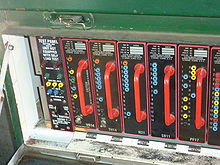- EMD Dash 2
-
On January 1, 1972, General Motors' Electro-Motive Division (EMD) introduced its new Dash 2 line of diesel-electric locomotives. All designations of these new models were those of the former models with "-2" added (e.g., the SD40 was replaced by the SD40-2). They all retained the basic specifications of the earlier models in terms of power output and most other features, but introduced a large number of improvements to the locomotives' internal systems, specifically the electrical systems. These were intended to improve availability, efficiency, and ease of maintenance.
One major improvement was a modularized electrical control cabinet, allowing maintenance by unit replacement and the use of common parts. These concepts were first tested on the DDA40X.
Contents
Changes
Minor externally visible changes common across the whole line include the following:
- Modified trucks with damping struts. Four-axle trucks have damping struts on two diagonally opposite corners. Six-axle trucks have them on the center axle.
- Engine water level sight glass on the rear upper right-hand side of the long hood.
- Battery boxes in front of the cab have bolted down covers, rather than hinged.
- Equipped with both high and low positions for rear classification lights, one set being blanked.
- Cab roof extends slightly beyond the cab rear.
Models
The Dash 2 line was highly successful. The models offered included the following:
- F40PH
- GP38-2
- GP38-2W
- GP39-2
- GP40-2
- GP40-2L(W)
- GP40-2W
- GP40P-2
- SD38-2
- SD40-2
- SD40-2F
- SD40-2W
- SD40T-2
- SD40-2S
- SD45-2
- SD45T-2
Rebuilds
In addition, many other earlier locomotives were rebuilt to Dash 2 standards by numerous locomotive rebuilders and railroad shops.
References
Locomotives built by EMD Switchers Four axle
road powerSix axle
road powerEight axle
road powerCab units
(F- & E-units)Cowl units Electrics Industrial, military,
export and narrow gaugeStreamliners - M-10000
- M-10001
- M-10002
- M-10003 to M-10006
- Pioneer Zephyr
- General Pershing Zephyr
- Green Diamond
- Flying Yankee
- Aerotrain
Experimentals and
aftermarket conversionsCategories:- EMD locomotives
- Diesel locomotives of the United States
- Railway locomotives introduced in 1972
Wikimedia Foundation. 2010.

